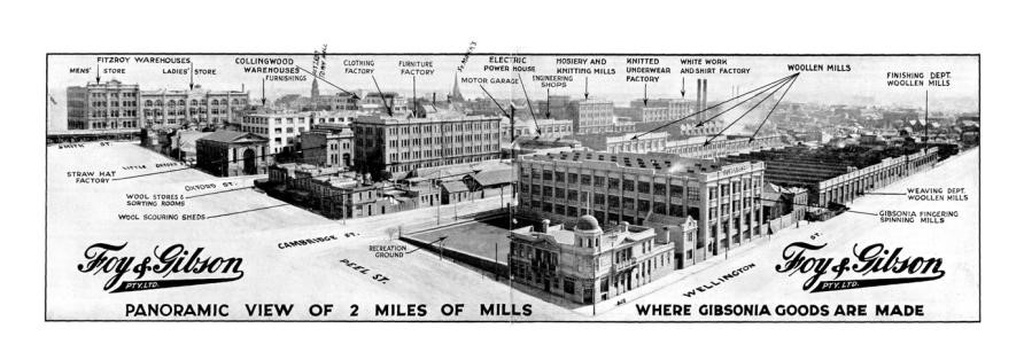
The Foy and Gibson factories occupied sites between Stanley, Wellington, Peel and Little Oxford Streets in Collingwood. The Foy and Gibson flagship store had been opened on Smith St Collingwood in 1883, established by William Gibson and Francis Foy, and to meet the demand for their growing business, Gibson oversaw the construction of factory complexes on the Wellington St sites from 1887 onwards, which were known as “Gibsonia”. Foy and Gibson’s factories manufactured a wide range of textiles including Manchester, men’s and women’s clothing, along with other homewares, furniture, and hardware. The manufacturing process on the Gibsonia site was systematic, with factories included a weaving room to spin fibres and weave cloth, which was then made into clothing, blankets and homewares. Administration and home delivery services were also housed on the site alongside the factories, making this a large industrial complex meeting all the needs of the growing Foy and Gibson department store chain. Foy and Gibson factories were unusual employer in the late 19th and early 20th centuries, in that it gave workers public holiday leave, and an 8 hour working day (which Melbourne stonemasons fought for in 1856, though many industries took decades to reduce working days to this standard.) The factories also hired men and women to work at the same tasks alongside each other, which was also unusual in manufacturing at this time. The products made at the Gibsonia site were distributed nationally, and by the early 20th century these factories were one of the largest employers in Victoria, and often referred to as “the largest factory in the Southern hemisphere.” Foy and Gibson was taken over by Cox Brothers in 1955, however the company went into liquidation in 1968, ending over 80 years of manufacturing at Gibsonia. There are a number of remnants of the Gibsonia works in this area, including the oldest remaining buildings at 79-93 Oxford St, and the boiler house at 150 Oxford Street.
by laurenpiko on March 1, 2019Please login to comment on this item